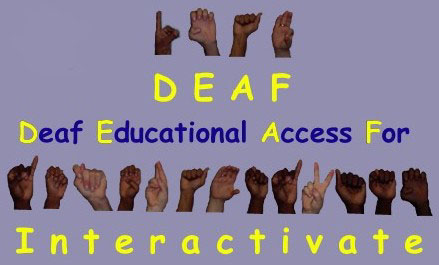
 ASL | Worksheet To Accompany the "Surface Area and Volume" LessonThis worksheet is intended for use with the lesson Surface Area and Volume. |
 ASL | For the following questions, use the rectangular prism: |
 ASL | What is the smallest volume that you can create with this prism? _______________ |
 ASL | What is the surface area associated with this volume? _______________ |
 ASL | What is the width? _______________ |
 ASL | What is the depth? _______________ |
 ASL | What is the height? _______________ |
 ASL | What is the largest volume that you can create with this prism? _______________ |
 ASL | What is the surface area associated with this volume? _______________ |
 ASL | What is the width? _______________ |
 ASL | What is the depth? _______________ |
 ASL | What is the height? _______________ |
 ASL | Explain why the surface area is larger than the volume in #1.
|
 ASL | Can you make the surface area and volume have the same value? If so, what are the dimensions of the prism at that time? How close can you get?
|
 ASL | Are the two values really the same (or close to the same) with these dimensions? Hint: What are the units for each of the values? Are the units the same?
|
 ASL | Change the rectangular prism so that it is as large as possible in every direction. |
 ASL | In #2, you found that the largest possible volume of the rectangular prism was _____________. |
 ASL | How do you think the largest possible volume of the triangular prism will compare to the volume of teh largest possible rectangular prism? Will it be larger or smaller? |
 ASL | How much larger or smaller? |
 ASL | Write your guess and reasoning here and then choose the triangular
prism to check it:
|
 ASL | Was your prediction correct? What is the ratio of the volumes of the largest possible rectangular and triangular prisms? |
 ASL | Does the same ratio always hold true for triangular and rectangular prisms with the same dimensions? |
 ASL | Do the values for the surface area of the triangular and rectangular prisms have the same ratio that you discovered in #6? Why do you think this is true? |
 ASL | Let's take a look at how we would calculate the surface area of the triangular prism. Please set all dimensions at 14 units for this exercise: |
 ASL | Click on "View front". This view looks like a triangle. The base is 14 units and the height is 14 units. Since the formula for the area of a triangle is:
Please show your work:
|
 ASL | Click on "View side". This view looks like a rectangle that is slanted into the screen. The base is 14, but what is the height?
Can you use the Pythagorean Theorem to find the height of this rectangle?
Hint: The height of this rectangle is the hypotenuse of a triangle in
another view!
|
 ASL | What is the area of this side of the triangular
prism? Show your work:
|
 ASL | Click on "View top". This view looks like a corner view of a regular rectangle. Click and drag the prism so you can see the underside. The area of
this bottom face of the prism is _____________________. Please show your work:
|
 ASL | Now, since the triangular prism has ____ faces that look like "View front", ___ faces that
look like "View side", and ___ faces that look like "View top"(bottom), we can add the area
of the 5 faces to get the total surface area. What is it? Show your work:
|


Developed by
The Shodor Education Foundation, Inc.
Copyright © 2002 by The Shodor Education Foundation, Inc
This project is supported, in part, by the National Science Foundation
Opinions expressed are those of the authors and not necessarily
those of the National Science Foundation.
